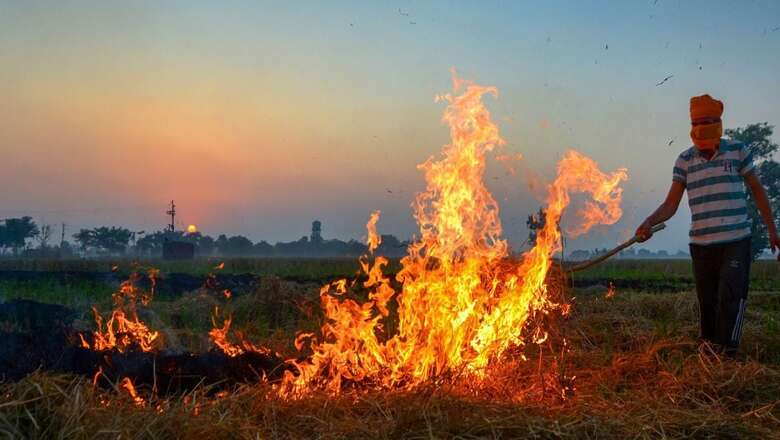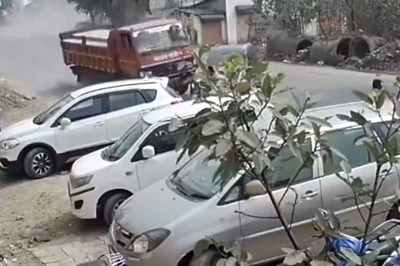
views
The recent rebuke by the Supreme Court on stubble burning has highlighted some critical concerns about paddy cultivation in Punjab, implying that farmers need to consider sowing other crops instead of paddy to tackle the issue head-on. The Supreme Court has also asked for a meeting with farmer groups to find a sustainable solution to the problem, which is a crucial step in the right direction.
The central and state governments should take ownership and collaborate to help farmers find a solution to the issue. It’s imperative to realise that if we can send Chandrayaan-3 to the moon, we can certainly find a solution to stubble burning.
The action taken against Punjab farmers in the form of more than 250 FIRs is not a wise solution. Years of awareness campaigns in the state, along with Rs 1,000 crore worth of subsidies on straw management machines, have not led to any big shift away from stubble burning. There is a need to find a more practical solution to this problem that takes into account the challenges faced by farmers, who do not want to burn stubble anymore; instead, they want support for managing the residue effectively.
Every winter, smog combined with farm fires, household cooking, crackers, diesel-driven SUVs, commercial vehicles, industries, dust, and other factors contributes to the worsening of air quality. Although it is a national problem, stubble burning is usually associated with farmers in Punjab and Haryana who are unfairly blamed by urban dwellers and policymakers.
This perception is not only misguided, but also a serious lapse on the part of policymakers to address a problem practically. It is time to recognize that farmers and their families are the first victims of pollution caused by stubble burning pollution. Obduracy and a mental block are seen as the main obstacles to finding a solution. There is a need for better and more intelligent solutions to address this existential issue. It is crucial for policymakers to take practical measures to combat this problem and ensure a safe and healthy environment for all.
Stubble burning after paddy harvesting is banned, but it continues to occur frequently in Punjab, Haryana, Uttar Pradesh and other parts of the country. The current solutions to this problem have not been effective. Although a subsidy scheme for employing a stubble residual machine has been implemented, it has had limited success.
Most small and medium farmers find it unaffordable. The National Green Tribunal (NGT) banned stubble burning in 2015, and Punjab authorities fine farmers who violate the ban. However, coercive methods and monetary penalties have not been effective in deterring farmers from burning stubble.
The narrow gap between the paddy harvest and the wheat-sowing time in Punjab and Haryana exacerbates the issue of rice straw. The paddy crop is usually harvested between the first and last weeks of October, and farmers sow the wheat crop from the first week of November. The combined harvester and thresher machine often leaves behind a significant amount of stubble on the field, which prevents other machines from sowing wheat seeds.
With only a 10-15-day window between the paddy-harvesting season and the wheat-sowing time, farmers feel compelled to burn the stubble to quickly clear the fields.
The Indian Council of Agriculture Research (ICAR) has claimed success with a bio-decomposer spray called ‘PUSA’, which can decompose most of the stubble into manure in a month. Nevertheless, the use of bio-decomposers in Punjab has not shown favourable results in trials, given the narrow gap of 10 to 15 days for sowing wheat after the paddy harvest.
The current slow progress in curbing stubble burning demands a practical commercial model that can effectively bring about a perceptible change in the atmosphere and people’s attitudes. Fortunately, some private firms in Punjab have taken the initiative to buy stubble from farmers and produce gas and other by-products in biogas plants. However, these ventures need encouragement from the government to succeed.
Global Solution to Local Problems
In today’s globalized world, it is important to find global solutions to our local problems, such as paddy straw burning. India could learn from other countries’ experience, where similar bans on crop residue burning failed to persuade farmers. Therefore, relying solely on government initiatives to solve this problem may not be effective due to the high levels of animosity among paddy cultivators.
To solve the problem of crop residue burning, technical and legal interventions alone are not enough. It’s essential to focus on minimising the costs for farmers who opt for alternative methods of paddy straw disposal and supplementing their sources of income. In Egypt, the government offered an incentive to traders to buy straw from farmers.
Suggestions for alternative disposal methods include using it for animal feed, ploughing it back into the field as natural fertilizer, generating bio-energy, and using it as a substrate for mushroom cultivation.
The Way Forward
Farmers often find it difficult to stop the age-old practice of stubble burning. This is because alternative methods of stubble management require additional expenses, which are usually borne by the farmers themselves. The cost of stubble management ranges from Rs 5,000 to Rs 6,000 per acre, but the proposed centre and state incentives of Rs 2,500 per acre are currently on hold.
Ignoring the problem is not a solution either. Therefore, it is important to provide farmers with free reaper binders and paddy straw choppers at their farm gates to help them manage stubble effectively.
The state government can help by arranging to procure the stubble along with paddy grain, by hiring balers to work for free for the farmers. This will help them prepare their farms for wheat sowing after paddy harvesting. The stubbles can then be sold to biomass-based power plants, paper mills, and cardboard factories.
In the long run, replacing long-duration paddy varieties with shorter-duration varieties like PUSA Basmati-1509 and PR-126 can help reduce stubble burning. These varieties can be harvested in the third week of September itself, which will allow ample time for the paddy stubble to decompose, eliminating the need for stubble burning.
Providing farmers with the necessary assistance and equipment can encourage them to refrain from burning stubble. We all know that stubble retention has many benefits, but it requires a systems approach to manage disease, pest and weed pressure. Farmers need to be educated on how they are harming their farms by damaging the soil’s nutrients.
The author is Vice-Chairman Sonalika Group, Vice-Chairman of the Punjab Economic Policy and Planning Board, Chairman of ASSOCHAM Northern Region Development Council and Chairman Tractor and Mechanization Association (TMA). Views expressed in the above piece are personal and solely that of the author. They do not necessarily reflect News18’s views.

















Comments
0 comment